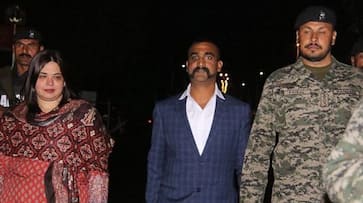According to the Geneva Convention, any conflict arising between two or more countries which involves the armed forces is an armed conflict and the personnel captured during such an event has to be treated as a POW
New Delhi: The release of Indian Air Force (IAF) pilot, Wing Commander Abhinandan Varthaman by Pakistan, is being seen as ‘gesture of peace’, but the fact remains that Pakistan was bound to release him in compliance with the Geneva Convention.
Pakistan sympathisers continue to bat for Imran Khan, terming Varthaman’s quick release as an ‘magnanimous’ act by the Pakistan Prime Minister, but according to experts, Pakistan was bound to do that.
This is not the first time that a soldier in captivity was released. Earlier, Pakistan had released Flight Lieutenant Kambampati Nachiketa during the Kargil War in 1999, which was also in compliance with Geneva treaty on prisoners of war (POWs).
Also read: Indians who shamed nation, gained Pakistan media's applause
Wing Commander Varthaman returned to India on Friday, two days after he was captured while engaging in an aerial dogfight with Pakistani F-16s.
However, there are many who are arguing that the Geneva Convention only applies to POWs, and as the two countries had not declared a war, Varthaman does not fall under the POW category. This is another false information being circulated by Pakistan as Varthaman indeed qualified to be treated as a POW.
Various commentaries on the Geneva Convention (III) make it crystal clear that any conflict arising between two or more countries which involves the armed forces is an armed conflict and the personnel captured during such an event has to be treated as a POW, which made Varthaman a POW and Pakistan was bound to release him.
A clause in the convention states that as soon as the hostilities end, the POW must be surrendered to his country of origin. According to Article 118 of Convention III, POWs “shall be released and repatriated without delay after the cessation of active hostilities”.
In the case of the IAF Wing Commander, Pakistan violated the Geneva Convention. The convention states that all POWs have to be protected against insults and public curiosity as well as acts of violence or intimidation. In this context, Pakistan crossed the line when its military spokesperson tweeted an image of the captured IAF pilot. What's worse, videos of Varthaman circulated by Pakistan had the pilot saying how the Pakistani army saved him from a blood-thirsty mob and that he respected the Pakistani military for being 'professional'. The Geneva Convention also strictly bar airing pictures of captured prisoners on television.
What is the Geneva Convention?
The Geneva Convention was adopted in 1949 in the backdrop of the Second World War. However, the four treaties, with three protocols added since 1977, continue to form the basis of the Geneva Convention and apply today to situations of armed conflicts. The convention has been ratified by 196 countries.
The first treaty requires that all wounded and infirm soldiers, as well as medical personnel and chaplains in the field, be treated in a humane manner without discrimination on the basis of race, colour, gender, religion, faith, and the like. It prohibits acts such as torture, mutilation, outrages upon personal dignity, and execution without judgment. It also grants them the right to proper medical treatment and care.
The second treaty extends the protection described above to shipwrecked soldiers and other naval forces, including special protection afforded to hospital ships.
The third treaty is related to the treatment of POWs, while the last focuses on the protection of civilians in times of war.
Last Updated Mar 3, 2019, 5:38 PM IST









![Salman Khan sets stage on fire for Anant Ambani, Radhika Merchant pre-wedding festivities [WATCH] ATG](https://static-gi.asianetnews.com/images/01hr1hh8y86gvb4kbqgnyhc0w0/whatsapp-image-2024-03-03-at-12-24-37-pm_100x60xt.jpg)
![Pregnant Deepika Padukone dances with Ranveer Singh at Anant Ambani, Radhika Merchant pre-wedding bash [WATCH] ATG](https://static-gi.asianetnews.com/images/01hr1ffyd3nzqzgm6ba0k87vr8/whatsapp-image-2024-03-03-at-11-45-35-am_100x60xt.jpg)


